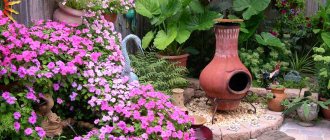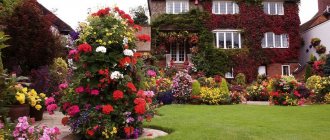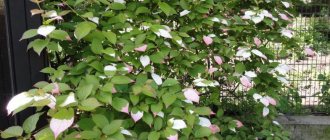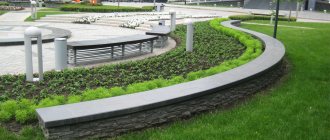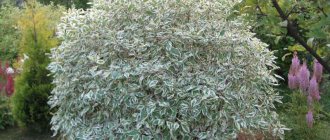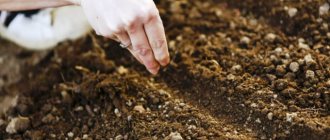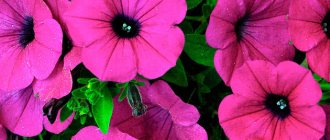Bulbs and cereals for flower beds
The appearance of the area around the house depends on what plants you plant in the yard. If you choose the right flowers, they will replace each other - when some fade, others will bloom, and the flowerbed will retain its decorative appearance. Some types of plants look spectacular even in winter.
In flower beds in local areas you can plant annuals and perennials, bulbous plants and low shrubs. Ornamental cereals and herbs are suitable for decorating flower beds. You can plant conifers on lawns - dwarf and creeping species will look especially good.
Bulbs are the first to appear in a flower bed - snowdrops bloom as soon as the snow begins to melt. They are being replaced by crocuses, muscari and hyacinths. In May, tulips and daffodils bloom, followed by anemones, irises and lilies. Garden callas bloom all summer. Closer to autumn, gladioli and dahlias bloom.
You should not pick leaves and stems of faded plants: the bulbs need them to bloom next spring. Over the summer, the bulbs must grow and accumulate nutrients, but without leaves they will not be able to do this.
At the same time as bulbous plants, ornamental cereal plants appear in flower beds and lawns. These are unpretentious plants, resistant to diseases and pests. They easily get along with various crops and tolerate both lack and excess of moisture. Cereals come in different heights and colors. They are planted along the edges of flower beds, on alpine hills and lawns. They look good at any time of the year:
- In early spring there is fresh young greenery and picturesque clumps.
- In summer, grasses grow and form various inflorescences - ears and panicles.
- Curtains covered with snow look spectacular in winter.
Suitable for flower beds: striped phalaris grass, haretail, pinnately bristle grass, setaria, cortaderia, feather grass and many other plants. In addition to cereals, you can grow herbs in flower beds and lawns: mint, oregano, basil.
Perennial flowering plants
Perennials are very convenient to grow in flower beds - you do not need to worry about seeds, seedlings and preparing the soil for planting every year. Many of them are unpretentious and bloom all summer. Such plants include:
- cornflowers;
- lobelia;
- perennial flax;
- aquilegia;
- garden tradescantia;
- yarrow;
- arabis;
- astilbe;
- delphinium and many others.
Roses require more care: they need to be regularly pruned, loosened and fed. They must be covered for the winter. Roses pay for their care with magnificent blooms that last all summer. At the end of the summer season, when many plants have finished blooming, autumn chrysanthemums bloom. They bloom until frost and fit perfectly into the garden composition.
Against the background of greenery, garden daisies look great and can decorate any yard. They are unpretentious: they tolerate drought well and do not require close attention. There are different varieties of daisies: large cornflower, red and pink pyrethrum, yellow doronicum. There are even terry varieties, similar to asters and chrysanthemums. Daisies combine well with other perennials and small shrubs.
A good addition to other plants that grow in the yard is gypsophila. This is an unpretentious flower, perennial varieties of which grow in one place for 25-30 years. Gypsophila is easy to care for - just water and feed occasionally.
Pelargonium is usually grown as a houseplant, but in the summer it can be transplanted into an outdoor flower bed. It develops well on the sunny side and produces many inflorescences in open ground. In order to grow pelargonium next year, you need to cut several cuttings and plant them at home.
What trees should not be planted?
At the same time, there are also those trees that it is better not to plant. Experts do not recommend planting in the yard of a private house:
- Oak - foreshadowing the death of the head of the family. It is believed that the aura of the tree accepts only strong and healthy people, and its energy can be destructive for household members.
- Walnut and poplar - can be used on the site, but away from outbuildings, since the root system of these trees can damage the foundation.
- Willow - brings bad luck and takes with it the same year the one who planted it. It is also forbidden to plant willow in honor of the birth of a child.
- Aspen - bring grief and death to the family.
- Pine is a tree that can destroy all the plants surrounding it.
Tall and low annuals
Annual flowers are suitable for those who like variety in their flower beds - they can be used to create picturesque compositions. Annuals are often planted in flowerpots and flowerpots. Everyone is well aware of the following names of plants in the yard that are planted every year:
These flowering annuals are unpretentious and do not require much care. They grow quickly and bloom all summer.
Marigolds are one of the plant species most common in the middle zone. There are a large number of different marigolds: terry, smooth, chrysanthemum-shaped. Their color ranges from lemon yellow to dark brown. New varieties of flowers are constantly appearing. Marigolds have medicinal and insecticidal properties. They easily tolerate transplantation in a blooming state, which is why they are used to fill empty spaces in flower beds.
Zinnias are bright large flowers of various colors that look good in flower beds, rockeries and alpine hills. They prefer sunny places. Petunias, beautiful flowering plants of various shapes and colors, are extremely popular among designers. Low-growing varieties are used to decorate flower beds, and cascading varieties are grown in flowerpots.
Asters are also well-known and popular flowers. They bloom in summer and bloom until late autumn. There are many varieties of asters - low-growing and tall, simple and double. Suitable specimens can be selected for any flower garden.
Flowers for borders
Low-growing flowers are used for planting along the edges of flower beds. They do not cover the plants planted behind them and do not spoil the overall appearance of the flower garden. The most popular of them are:
- pansies;
- periwinkle;
- purslane;
- primrose;
- Turkish cloves.
Pansies can be planted in shaded areas. These flowers come in a variety of colors, form lush bushes and serve as a good decoration for a flower bed. Turkish carnation grows quickly and covers the empty spaces of the flower garden. It has a subtle and delicate aroma. Small decorative carnation inflorescences delight all summer, and some species bloom again in the fall.
Purslane is suitable for planting in flower beds located in bright sun. This plant spreads along the ground and covers empty areas well. It grows quickly and blooms with beautiful bright flowers. Purslane is not only beautiful, but also edible - its young stems are used for salad.
How to remove a tree near the house?
An old tree can serve as a decoration for a garden and plot, but it is dangerous, because in a strong gust of wind it can break or fall on the roof of a private house. Based on this, it is better to play it safe and remove the tree, trusting specialists who have experience and the necessary equipment. As you know, a tree is never completely cut down; you need to start with medium and large branches, after which the plant is gradually sawed from top to bottom and taken out by truck.
Flowering shrubs
Shrubs are traditionally used to decorate the area near the house. They require much less care than flowers. Shrubs can be either flowering or fruiting. The following unpretentious and frost-resistant plants are usually planted in home areas:
Read also: How to resolve a conflict with a client
- Lilac, whose fragrant clusters bloom in early spring. Caring for it is simple - the bush is occasionally watered, fed and dry branches are cut off.
- Spiraea is a lush flowering shrub with spectacularly colored flowers and leaves. He is unpretentious and hardy. Spiraea is used in various landscaping options. You can choose varieties that bloom in both spring and autumn.
- Budleya is a shrub that blooms with large flowers of different shades of lilac. Flowering continues from July until late autumn. Immediately after its completion, the bush needs pruning.
- Hydrangea delights gardeners all summer with its large, elegant inflorescences. It needs regular feeding and mandatory pruning. The plant tolerates even the most severe frosts well and does not need shelter.
- Weigela blooms twice a year - in spring and late summer. Its flowers come in the form of white, pink, red and cream bells. This heat-loving shrub develops well in a dark place and needs shelter in winter.
- Deutzia is an exotic plant that recently appeared in our gardens. During flowering, it is completely strewn with small white, pink or brown flowers. Deutzia looks great against the backdrop of conifers and forms spectacular compositions in combination with other flowering plants.
- Thorn is a shrub whose fruits can be eaten. Its growth can reach three meters, so the plant must be pruned regularly. Blooming thorns give off a pleasant aroma.
- You can also plant rose hips, viburnum and hawthorn in your yard. These shrubs bloom beautifully in the spring, and bright and elegant fruits ripen on them in the fall. They are unpretentious in care and are highly frost-resistant.
Long gone are the days when, to decorate your summer cottage or small garden, it was enough to simply sow marigolds or asters. Nowadays, designing your garden is an integral part of landscape design. Even a novice gardener can decorate his flower garden with his own hands without much effort. To do this, you need to understand at least a little about some plants or flowers for flower beds.
Plants for flowerbed decoration
Selecting beautiful and unpretentious flowering plants for your garden is not such a difficult task. The only difficulty here will be not to plant all the flowers in a chaotic order. That is why it is worth understanding in more detail which flowers are best suited for planting in flower beds.
Sun-loving perennials
Onion perennials begin to please the eye from the moment the first spring rays appear. Flowers give way to each other . Snowdrops are being replaced by crocuses and hyacinths. Next, tulips, irises and daffodils begin to bloom. In May, sunny flowers - lilies - bloom. When summer comes, the bulbous flowers go into a dormant period. The leaves begin to fade, and the bulbs will rest until next spring.
But this does not mean at all that in the summer the garden should look like an abandoned wasteland. It can be diversified with flowering perennials and herbs:
- Hosta;
- Chamomile;
- Sedum;
- Chistets;
- Veynik;
- Feather grass;
- Spicy herbs in the form of basil, oregano, mint.
Perennials that bloom in summer will please the eye much longer . Of course, one cannot fail to mention the rose here. Most varieties of roses are ideally combined with coniferous shrubs, the greenery of which sets off the bright buds.
A flower garden with gladioli will be especially colorful. These flowers grow and bloom in the flowerbed, giving the garden a certain majesty and luxury. Gladioli are bulbous plants. They will feel great in the garden surrounded by the following perennials:
- Bells;
- Delphiniums;
- Lobelia;
- Anemones;
- Yarrows;
- Sage.
Pelargonium, which is often popularly called geranium, can often be seen in pots on windowsills. But this does not mean that the plant is not suitable for an outdoor flower bed. Pelargonium is very easy to care for and produces a lot of inflorescences. It is preferable to grow on the sunny side or in the least shaded place.
Chrysanthemums are very popular and will fit perfectly into a garden composition. Chrysanthemums begin to bloom in August. The flowering period of these flowers ends only with the onset of the first frost . Chrysanthemums will look great in the autumn garden.
Chamomile can brighten up any yard. Such flowers can often be found even in the courtyards of schools. Chamomile can fit perfectly into the garden with other perennial plants. She is very easy to care for and will never cease to please the eye. Chamomiles can also be combined with small shrubs.
Annual flowers in the yard
Annuals are the perfect solution for those who like variety in their garden. Annual flowering plants make it possible to create unique compositions in flower beds every season. Such flowers can be used both to decorate mixborders and modular flower beds. Annuals are often planted in pots to decorate their summer cottage.
The most common annual flowers are:
Many people probably think that the above flowers have long become boring and lack any originality. However, with the right choice of varieties and the correct composition, these “boring” plants will take on a completely different look.
Few people know that marigolds in their genus include more than 3 species. In Russia, upright and deviated species can most often be found. If we talk about the color scheme, it starts from dark red and ends with a lemon shade. Some varieties are distinguished by their mixed colors.
Zinnia, often called major by gardeners, is a large, bright, hollow flower. Zinnia tolerates the sun well without losing its rich colors. This flower plant is perfect for a rustic flower bed. Only asters can compete with them.
Petunia can rightfully be called one of the most beautiful flowers in the garden. This flower has gained such popularity due to its variety of shades. There is a place for petunias in any flower garden. hanging pots has become especially popular .
Poppies are one of those flower plants that will add diversity and brightness to the overall background of a flower bed. It is also worth paying attention to flowers similar to poppies, which are called “Eschscholzia Californian”. Externally, this plant is very similar to poppy, the only difference is the yellow inflorescence. Plants will feel ideal among bushes.
Read also: How to attach blinds to plastic windows video
Lavender is an ornamental plant that is often used in perfumery. And this is not surprising, because the flower stands out clearly from the rest with its pronounced aroma. In addition, lavender also has excellent external characteristics. This stunning purple flower will brighten up any garden.
Low growing flowering plants
Very often you have to use low-growing flowers to decorate borders . They have become very popular due to the fact that they do not stretch upward and do not stand out too much from the overall picture. The most popular types of low-growing flowers include the following:
- Purslane;
- Periwinkle;
- Carnation;
- Pansies;
- Primrose.
For a small flowerbed that is located in the scorching sun purslane is ideal . By the way, it is worth noting that this plant is not only beautiful, but also edible. Its stems are often used to make salads. If we talk about decorative purposes, purslane is planted in flower beds because of its unusual ability to spread along the surface of the ground. Thus, the flower covers the empty areas of the flower garden.
Pansies , unlike purslane, prefer to grow in a shaded place . These are low flowers that grow in lush bushes. Pansies are often confused with blue forget-me-nots, which are also ideal for open flower beds.
Turkish ground cover carnation is another leader of low-growing ornamental flowers. In addition to the fact that this type of carnation is able to fill the free space in the flower garden, it is also distinguished by its rapid growth. Clove inflorescences are not very large, but have a pleasant aroma that will delight you throughout all sunny days.
Blooming all summer
There are plants that bloom for only a few days in March, and there are those that continue to delight the eye throughout the summer. Such plants include asters, which were already mentioned above. But she deserves a little more attention.
Aster has bright inflorescences that look like stars. The plant blooms throughout the summer . These flowers are suitable for absolutely any garden, because they have many species in their genus. Aster varieties can be tall, short and of any color. The choice can only be made based on personal preferences and overall landscape design.
It is in no way inferior to the dahlia aster, which is often used by florists in creating bouquet arrangements. As for flower arrangements, the dahlia will be in place here too. This plant, like the aster, blooms throughout all three summer months, but does not have time to get bored.
Remontant roses will be an excellent choice for decorating your garden. Their main feature is that after some buds fade, new ones immediately appear in their place. That is why roses bloom until autumn.
Gypsophila is not so common, but they are also great for decorating a flower bed. It is worth noting that these plants can easily get along on rocky slopes, so they will be an ideal option for rocky flower beds.
Don’t forget about climbing flower plants , which can be used to decorate mixborders, fences, walls and gazebos. These flowers include clematis. Clematis has large inflorescences that stand out against the general background. Externally, this plant can be compared to tropical vines.
Owners of dachas and personal plots use their properties differently. Some cultivate a vegetable garden and reap rich harvests, others prefer a lawn instead of beds. But it is rare to find a garden plot without a flower bed or flower bed. The word “flower garden” seems to speak for itself and implies a place where flowers grow and smell fragrant.
Main characteristics
In landscape design, there is a special class of herbs that either do not bloom at all or bloom unnoticed. These are ornamental herbaceous plants. Some look so impressive that it is no longer possible to imagine a modern flowerbed or front garden without them. There are a great many herbaceous plants in nature. There are about 18,000 of them in Russia alone. But of course, not all herbs can be classified as ornamental.
Herbaceous plants are plants that do not have perennial above-ground characteristics, they do not have woodiness of the stem, and at the end of the growing season they die off. Herbs form a root system and shoots: leaves, stem and flower part, if any.
Classification of herbaceous plants
Herbaceous plants are classified according to various criteria. But grouping plants by lifespan is considered the most convenient. Their examples:
- Annuals, after completing the growing season or flowering and fruiting, die off completely, without the possibility of resumption of growth. Such plants reproduce exclusively by seeds.
- Biennials complete their life cycle in two years. During the first season they develop shoots and roots. At the end of the growing season, their stem dies off in the same way as that of annuals, but the underground part survives to produce flowering shoots next year. Complete death occurs at the end of flowering.
- Perennials differ from biennials by the presence of rhizomes, bulbs or tubers, which have a longer renewal period. But their above-ground shoots die off in the same way when the growing season ends. After a year, under the influence of heat, new roots and young shoots sprout from living tissue.
Ferns
Ferns are one of the most ancient plants, widely distributed around the globe, but most often found in moist forests. These plants were able to adapt to different living conditions, and are able to grow not only in the soil, but also on trees, in rock cracks, even in the desert.
The sizes of ferns range from very tiny to large tree-like forms up to 25 m high. They are distinguished by beautiful long leaves that look like feathers.
Rice. 2. Ferns.
Ferns have a root, a short stem and large leaves, but they never bloom. These plants do not have seeds. Instead, they form spores, with the help of which they reproduce.
Decoration of the world
Decorative plantings are widely used to improve the landscape: near houses, grasses are displayed in flower beds and front gardens, they decorate squares and park areas in cities. Thematic compositions and modular flower beds, porters and borders are created from annuals, biennials and perennials.
Conventionally, ornamental plants are divided into deciduous and flowering:
- decorative deciduous - mosses, cereals and ferns;
- beautifully flowering - flowering plants and meadow grasses.
Today, the range of herbs is diverse, which makes the choice much more difficult. But the decision should be made based on more than just appearance. It is important to know the growing conditions and other characteristics, which may differ significantly depending on the type of plant.
Decorative deciduous grasses
Plants with decorative foliage delight the eye with splendor and variety from spring until the first frost.
Wormwood is a biennial or perennial herbaceous plant. There are many types of wormwood, and some are even listed in the Red Book of Russia.
Most types of wormwood grow up to 60-70 cm in height, but there are also those whose growth can exceed 1.5 m. The stems of the plant are straight and branched, pubescent. The leaves are elongated and pointed, silvery in color. The flowers are small, collected in inflorescences, usually white or yellow. Wormwood has a pleasant aroma with a slight bitterness.
To grow decorative wormwood, you need well-drained soil and a site located on the sunny side.
Mint is not only a healthy and fragrant herb, it also has decorative properties. Mint is a perennial plant with many species, but the most common are fragrant and peppermint.
Read also: Yeast dough with whey for fried pies
The stems of fragrant mint reach a height of up to 40 cm, they are straight and stable. The leaves are green with a light edge, wrinkled, and exude a pleasant aroma.
Peppermint can reach a height of 120 cm. Its stems are straight, tetrahedral, branched, and well-leafed. The leaves are green with a purple edge, elongated-ovate, pointed and jagged.
Mint is an unpretentious plant, but it grows and reproduces better in fertile and well-moistened soil. More illuminated areas are optimal for growing.
Sheep fescue is an ornamental grass. The plant does not form a rhizome and differs from other fescue trees in its softer foliage.
Sheep fescue grows in a dense bush, growing from 20 to 140 cm in height. The leaves are bristly and can be different in shape: from wide to especially narrow. Fescue blooms with oblong panicles of light green spikelets.
It is recommended to grow sheep fescue in a bright and warm place with low humidity. It tolerates drought well and responds well to pruning.
Beautiful flowering plants
Beautifully flowering herbs will enliven and decorate any corner of the garden, and the name itself already speaks for itself.
Adonis is a flowering herbaceous plant; in summer, this beautiful flower can be found in the European part of Russia and Western Siberia. There are two types of Adonis: spring and summer.
A plant often has more than one stem; they can be simple or weakly branched, erect or deflected. They grow up to 40-50 cm in height. The leaves are very thin and stick out in different directions, because of this it seems that the stem of the flower is shaggy. Sunny places are preferred for growing.
Spring adonis is a perennial, so it is more popular than summer adonis. The flowers are solitary, bright yellow, quite large - up to 8 cm in diameter. Thanks to its early flowering, it looks very impressive against the background of coniferous plants.
Summer adonis is an annual that blooms all summer until September. It differs from its counterpart not only in the flowering period, but also in color. The flowers of summer adonis are fiery red with black spots. Outwardly it resembles a poppy.
Delphinium is a fast-growing and unpretentious herbaceous plant. But despite their exquisite appearance and stunning beauty, even wild species take root well in gardens and do not require special care.
There are many types of delphinium. From dwarfs, whose height does not exceed 20-30 cm, to giants, capable of growing up to 3-4 meters. The leaves are separate, dissected, slightly hairy. Inflorescences are in the form of panicles or racemes; only some species form single flowers. The color of delphiniums is often blue or purple, but the most popular flowers are red and yellow.
Delphiniums should be grown in shaded and windless areas with moderately moist soil. They respond well to organic fertilizers. Delphinium is resistant to drought and low temperatures; there is no need to cover them for the winter. Upon completion of flowering, it quickly loses its attractive appearance, so gardeners advise choosing neighbors with a long flowering period.
Iris is a perennial with large beautiful flowers of various colors and shades. Irises are a real decoration for any flower bed or alpine hill; they get along well and combine effectively with many other plants.
The growth of irises is from 40 to 60 cm. The leaves are flat, thin, sword-shaped. The flowers are solitary, of unusual shape. They usually bloom from May to July.
To date, 280 species of irises are known. Most of them are unpretentious and grow equally well in both shade and sunny areas. Irises do not tolerate excess moisture, so they should be watered sparingly. But they do not need frequent replanting and can grow in one place for more than five years.
Evergreen herbaceous
Evergreen herbs will become the main decoration of the garden in late autumn, and in the spring they will welcome you with living green foliage.
Heuchera is a ground cover perennial herbaceous plant. Through the efforts of breeders, many varieties have already been developed that differ in the shape and color of the leaves. For example, purple heuchera has bright and rich purple leaves, while green heuchera has variegated leaves with light green veins.
It reaches a height of 40-60 cm. The leaves are medium-sized, lobed, rounded-heart-shaped. During the flowering period, the plant is covered with small inflorescences of red, white and pink shades, but is valued precisely for the beauty of the leaves.
Heucheras prefer shady places and do not require special care. When growing, excess organic fertilizers and abundant watering are undesirable.
Aubrieta is a beautifully flowering ground cover plant. Its shallow root system makes it ideal and indispensable for creating a fluffy green carpet.
The plant is rather short-growing, on average, the height does not exceed 12-16 cm. The leaves are small, with dense pubescence of a gray-green color. At the end of May, the flowering period of aubrieta begins, and by the beginning of June, all the foliage becomes hidden under a bright blanket of small flowers.
Aubrieta is undemanding about its habitat, but it takes root better in well-drained areas and loves the sun.
Bergenia is a unique perennial from the Saxifraga family, which can be found in almost every garden. Today, many hybrid varieties of bergenia have been bred; they are distinguished by their lushness and exotic appearance. This unassuming plant looks great in shady gardens and on the banks of ponds.
A low plant grows from 20 to 50 cm in height. Bergenia has large, dark green, shiny leaves in basal rosettes. Small flowers with a bell-shaped corolla are collected in inflorescences and have a variety of colors - from white and soft pink to bright red, purple and dark lilac.
Bergenia does not require a lot of light; it grows and develops well in shaded areas. In this case, it is necessary to monitor soil moisture, since this herbaceous plant does not tolerate prolonged stagnation of water. But bergenia can grow without replanting for ten years.
By skillfully selecting decorative plantings, even an inexperienced gardener will be able to add zest to his garden and make it unique.
Seaweed
Algae are inhabitants of water that differ from other plants in their simplest structure. They do not have roots, stems or leaves, and they absorb nutrients with their entire body.
The sizes of algae can be very different. There are absolutely tiny algae that can only be seen under a microscope. In summer, the water “blooms” when it acquires a rich green color. This color is given to the water by single-celled green algae.
In nature, there are also specimens that can reach a length of 40 meters. Such algae grow in the seas and oceans.
Rice. 1. Algae.
Small algae float freely in the water, while large ones attach to the bottom and form a real underwater jungle. The color can also be very different: brown, green, red.
Algae play a big role in nature:
- are food for water inhabitants;
- enrich water with oxygen;
- purify water from putrefactive bacteria;
- serve as a component of many medicines.
Mosses are small plants whose height does not exceed a few centimeters. These are one of the most ancient inhabitants of the planet, which appeared much earlier than dinosaurs.
Since mosses do not have true roots, they may appear weak and fragile at first glance. But this is not true at all. Mosses are extremely hardy plants that can survive in the harshest climates. But they prefer to live in damp, shady corners of the forest.
Externally, mosses are very similar to sponges and are able to absorb water. If you take a piece of moss in your hand and squeeze it, a lot of water will flow out of it.
